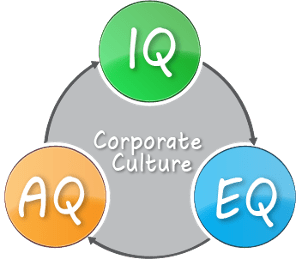
IQ and EQ are familiar concepts to most people, but there’s a new Q in town: AQ – otherwise known as Adaptability Quotient. According to scientists, it’s becoming the X-factor for career success and can be developed over time.
Adaptability is defined as the quality of being able to adjust to new conditions. A footnote in the definition says: Adaptability is an advantage in the harshly competitive global economy. So how does one learn to be more adaptable? I turned to Fast Company and a four-minute read written by Jennifer Garvey Berger:
- ASK DIFFERENT QUESTIONS.
The questions you usually ask will get you the sort of answers you usually get, which is not helpful when you need new ideas. Try asking a new question like: “What is most surprising in this situation?” or “What is at the edges of what seems possible today?” Different questions open you up to new possibilities and create a more flexible, agile mind-set.
- ACCEPT MULTIPLE PERSPECTIVES.
We often think we have taken a wide variety of perspectives into consideration when really we have mostly just asked the people whose ideas we already knew about. Our natural habits are to crave alignment and to work to convince those whose opinions differ (or ignore them). Seek out perspectives that are different and hold back on forming an opinion. Instead, actively listen.
- CONSIDER THE BIGGER PICTURE.
Our inclination is to pull things apart and solve the little pieces one at a time. Instead, when things are moving fast, look at the interactions. It’s like watching ice hockey: If you follow the puck with your eyes, you’ll be lost. If you zoom out and look at the patterns of the players on the ice, you’ll see the game.
- EXPERIMENT AND LEARN.
When it’s time to act, complexity calls for a series of safe-to-fail experiments – little bets that we can use to nudge the system in the desired direction. Instead of picking a final destination and trying to close the gaps, try finding places for experimentation and learning. The experiments should be small, inexpensive, and things you can learn from.
WHAT CAN I DO? Embrace these four tactics. The ability to adjust to new conditions is an important skill in a world where change is the only constant. In addition, having an advantage in our competitive global economy can only lead to good things. To your growth.


Leave A Comment
You must be logged in to post a comment.